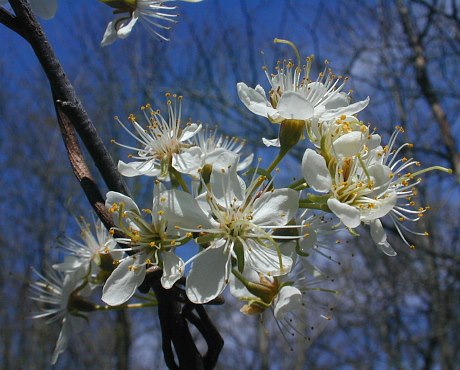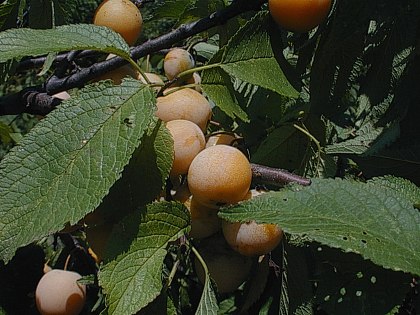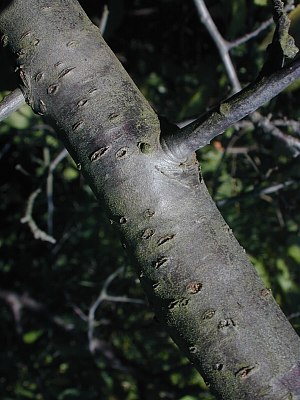Description: This is a small tree up to 25' tall. It has a stout short trunk and widely spreading to ascending branches. The trunk is up to 12" in diameter and it has rough grey bark. The bark of the larger branches is grey and smooth, except for some small lateral lesions. The bark of the smaller branches is greyish brown, smooth, and hairless. The smaller branches are rather contorted in their growth habit, and they have small stout twigs or spines. The alternate leaves are up to 4" long and 1¾" across; they are medium to dark green, ovate to obovate, hairless, and serrate or doubly serrate along their margins. The bottom of each leaf is rounded, while its tip is somewhat elongated. The upper surface of each leaf is slightly wrinkled in appearance, rather than smooth. The slender petioles of the leaves are about ½–¾" long and hairless.

At the axils of the leaves, there occasionally develops umbels of 2-6 flowers. Each flower is about ¾–1" across, consisting of 5 white rounded petals, 5 green sepals, a pistil with a prominent style, and numerous stamens. The sepals are much smaller than the petals; they are linear-lanceolate, smooth along the margins, hairless on the outside, and pubescent on the inside. The slender petioles of the flowers are about ½–1" long and hairless. The blooming period occurs from mid- to late spring for about 2 weeks; this usually happens before the leaves unfurl. The flowers have a pleasant fragrance. Fertilized flowers often develop into fleshy fruits that are globoid and about 1" across. These fruits are initially green, but they later become yellow or red (usually the latter) when they are fully ripened during the fall. The skin of each fruit is glaucous. The pulp of each fruit is fleshy and juicy; it becomes sweet when the fruit is fully mature. At the center of each fruit, there is a single large stone (a seed with a thick hard coat). This stone is ovoid and somewhat flattened, tapering at both ends. The root system is woody and branching; sometimes new saplings are produced from underground runners.

Cultivation: The preference is full to partial sun, mesic conditions, and a fertile loamy soil. This small tree is vulnerable to various diseases and insects.
Range & Habitat: The native Wild Plum is occasional to locally common throughout Illinois (see Distribution Map). This is probably the most common plum species in the state. Habitats include mesic woodlands, woodland borders, savannas, thickets, powerline clearances in wooded areas, and fence rows. This species benefits from occasional disturbance in wooded areas as it is unable to compete with larger canopy trees. For some reason, this species is not often cultivated.
Faunal Associations: The nectar and pollen of the flowers of Wild Plum attract honeybees, bumblebees, cuckoo bees (Nomada spp.), Halictid bees, plasterer bees (Colletes spp.), Andrenine bees, Syrphid flies, Tachinid flies, other flies, butterflies, and beetles. Bees are the most important pollinators of the flowers, especially Andrena spp. (Robertson, 1929). A large number of insects feed destructively on various parts of plum trees (some Prunus spp.). These insects include leaf beetles, weevils, scarab beetles, larvae of bark beetles, aphids, leafhoppers, treehoppers, armored scales, mealybugs, larvae of Argid sawflies, larvae of web-spinning and leaf-rolling sawflies (Pamphiliidae), larvae of common sawflies, larvae of twirler moths (Gelechiidae), larvae of Geometer moths, larvae of slug caterpillar moths (Limacodidae), larvae of hairstreak butterflies (Satyrium spp.), larvae of midget moths (Nepticulidae), larvae of owlet moths (Noctuidae), larvae of clear-winged moths (Sesiidae), larvae of Sphinx moths, and larvae of ermine moths (Yponomeutidae). The Insect Table provides more information about these species. Among vertebrate animals, the fruits of plum trees are eaten by the American Black Bear and, to a lesser extent, White-tailed Deer (Noyce & Coy, 1990; Sotala & Kirkpatrick, 1973). The Eastern Box Turtle and Ruffed Grouse also feed on the fruits (Ernst et al., 1994; Bennetts, 1900). The Deer Mouse and Franklin's Ground Squirrel feed on the pits of plum fruits, while Elk and White-tailed Deer browse on the foliage and twigs of these trees (Houtcooper, 1978; Andersen & Fleharty, 1967; Schneider et al., 2006; Martin et al., 1951/1961).

Photographic Location: The photo of the flowers was taken at the edge of a woodland in Piatt County, Illinois. The photos of the fruit & leaves and large branch were taken in a thicket along an abandoned railroad in Champaign County, Illinois.
Comments: Wild Plum has attractive flowers during the spring and attractive fruits during the fall. However, the leaves and fruits are occasionally disfigured by insects and disease. There are several plum species in Illinois. They differ from each other primarily in the appearance of their leaves and the characteristics of their sepals. For example, the leaves of Prunus nigra (Canada Plum) are more broad than those of Wild Plum, while the leaves of Prunus angustifolia (Chickasaw Plum) are more narrow. Wild Cherries are also Prunus spp., but their fruits are smaller in size (less than ½" across) and they are distributed primarily by birds, rather than mammals. There is a variety of Wild Plum that has leaves with pubescent undersides. It is referred to as Prunus americana lanata (Hairy Wild Plum). The typical variety has leaves with hairless undersides.